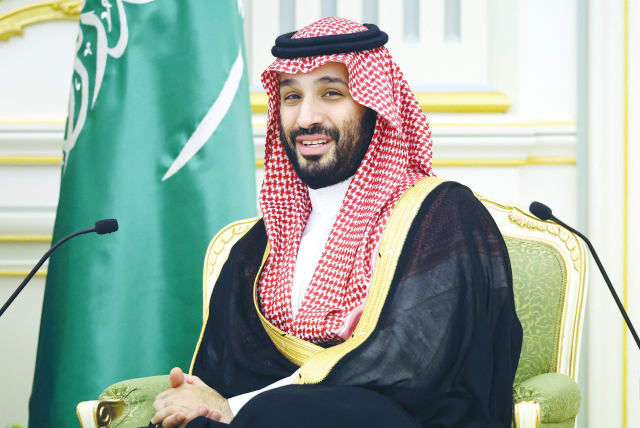Normalization with Saudi Arabia looks unlikely, but we should try anyway - opinion

Based on past experience with normalization agreements, three components are presently missing on both the Israeli and Palestinian sides: legitimate leadership, political determination, and trust.
Over four months have elapsed since the start of the war against Hamas, yet Israel’s objectives and vision for the “day after” in Gaza remain a mystery. At the same time, the United States, the European Union, Arab states, and a host of civil society organizations in Israel and abroad are energetically formulating various blueprints for ending the war and moving toward an agreement.
Israel’s reluctance to offer a plan for the aftermath of the war stems from political considerations, but the current Israeli government or its successor will soon have to take a clear stand.
In examining the “day after” options, it is necessary to review the points of agreement among the relevant parties.
All (or most) agree that Hamas cannot control Gaza or be involved in the post-war settlement, that the Palestinian Authority (PA) must undertake reforms, that Israel must elect a new government, and that some Arab states will provide economic assistance to rebuild Gaza and strengthen the PA. However, there is no agreement on who will rule Gaza, whether a Palestinian state will be established, and whether such an arrangement will constitute part of a broader regional deal.
Judging by historical precedent, military and political cataclysms breed change. The deadly results of the Hamas offensive and the resultant Gaza war are thus creating an opportunity for change in the regional architecture and the Israeli-Palestinian conflict.
However, based on past experience with peace and normalization agreements, three components are missing at present on both the Israeli and Palestinian sides: legitimate leadership, political determination, and trust. That leaves two options. One is to despair and give up, and the other is to examine how progress can be achieved despite these complexities.
A trustworthy mediator is key to any prospect of success. President Joe Biden has taken on this task and is determined to produce a landmark achievement ahead of the November 2024 presidential election. To that end, the United States, in cooperation with 10 European and Arab states, is reportedly drawing up a three-track arrangement.
One is intended to bring about a ceasefire in Gaza and a return of the Israeli abductees; the second is aimed at “reshaping” the PA; the third is the establishment of a Palestinian state in exchange for normalization between Saudi Arabia and Israel. A word of warning is warranted: the American Road Map for Peace plan of 2003 also consisted of stages but was halted at an early stage after the PA and Israel failed to fulfill their parts.
Incentives play an important role in optimizing the prospects of a settlement.
What are the incentives of each side?
The Palestinians’ main gain would be the establishment of a Palestinian state within the 1967 borders, with agreed territorial swaps – something they were denied after the Oslo Accords. This would include the reunification of the West Bank and Gaza, its acceptance as a member of the UN, and recognition by most countries.
Israel also stands to gain, obtaining guarantees for an agreement designed to prevent a security threat from the Palestinian side, an agreement with the most important country in the Arab and Muslim world (Saudi Arabia); continued integration in the Middle East, opening of new markets; building bridges with distant Muslim countries (Pakistan, Indonesia, etc.); easing resistance to Israel in the region and around the world given the solution to the Palestinian problem, and, finally, greater Saudi involvement in Gaza’s reconstruction, at Qatar’s expense or at its side.
If the Palestinian leadership rejects the emerging deal – as it has done with previous proposals – Saudi Arabia may see Israel’s outreach as a sufficient “fig leaf” for progress toward an agreement. Saudi Crown Prince Mohammed bin Salman (MBS) told US Jewish leaders in April 2018 that “over the past 40 years, the Palestinian leadership has repeatedly missed opportunities and rejected all the offers it was given. It’s time for the Palestinians to accept the proposals and come to the negotiating table – or shut up and stop complaining.”
The US-Saudi-Israeli peace deal under discussion would also reward the Saudis with American weapons, a defense agreement, and perhaps even a green light to develop nuclear civilian power. What is more, such a deal would allow the Saudis to boast that, unlike the Abraham Accords states, they indeed advanced the Palestinian cause, an achievement that would buttress Saudi leadership in the Arab world.
Surprisingly, the Saudis have not backed off their intention to promote normalization with Israel, despite the war with Hamas; perhaps not surprisingly, since they knew that Hamas and its Iranian backers had attacked Israel, among other reasons, to sink Israel-Saudi peace prospects. The Saudis have issued at least three positive statements in favor of normalization since the war began but have raised their price. Whereas before the war, they spoke vaguely about progress on the Palestinian issue, they are now demanding the establishment of a Palestinian state, although they could conceivably settle for less.
Four key issues preventing a deal
AT LEAST four hurdles stand in the way of a deal. The first is cognitive in nature. The growing assessment, reinforced by October 7 on both sides, is that the two-state solution is no longer viable. Affecting change in these respects is a long-term process of reshaping collective memories in ways that do not demonize the adversary – through the school system, the media, and other agents of socialization. Egyptian textbooks, for example, are only now undergoing an important change in the portrayal of Jews and Israel – 45 years after the peace treaty with Israel, obviously way too long.
The second hurdle is posed by the spoilers. Just as Hamas effectively disrupted the Oslo Accords and, along with Iran, sought to disrupt Israeli-Saudi normalization, it continues to pose a threat as long as it is excluded from emerging agreements.
Prospects of defanging Hamas will depend on the outcome of the war and whether it emerges weakened or victorious not only in the battlefield but also in the Palestinian perception. In any case, Islamists will remain central to Palestinian society and politics, and if political Islam accepts the new rules of the game, it can join a Palestinian electoral process. However, international and Arab guarantees will be needed to defend these new rules of the game.
The third obstacle stems from the core issues of the conflict with the Palestinians: Jerusalem and refugees. These are sensitive issues with explosive potential, requiring both sides to shift their thinking about the limits of feasibility. There is no need to reinvent the wheel, as numerous creative solutions have been suggested along years of negotiations since the Oslo Accords.
The fourth and perhaps most pressing obstacle is the political timetable. The Biden administration wants a deal before the November 2024 elections, while the necessary Israeli-Palestinian leadership changes could take much longer, if at all. Aaron David Miller, the veteran American Middle East analyst and negotiator, argues that there are two time dimensions in the Middle East: slow and slower. He believes the parameters for peace will have to await a second Biden term and new governments in Israel and the PA.
Given Israel’s preoccupation with the war in Gaza and potential war with Hezbollah, the fate of its abductees, and Hamas, Israelis may well regard talk of Saudi normalization and a Palestinian state as a fantasy. However, forward-thinking and policy alternatives create hope for a better future.
Winston Churchill described a pessimist as one who sees difficulty in every opportunity and an optimist as one who sees opportunity in every difficulty. Israel would do well to adopt the role of the optimist.
The writer is a member of Mitvim Institute’s Board of Directors and teaches at the Hebrew University’s Department of Islamic and Middle Eastern Studies.
Jerusalem Post Store
`; document.getElementById("linkPremium").innerHTML = cont; var divWithLink = document.getElementById("premium-link"); if (divWithLink !== null && divWithLink !== 'undefined') { divWithLink.style.border = "solid 1px #cb0f3e"; divWithLink.style.textAlign = "center"; divWithLink.style.marginBottom = "15px"; divWithLink.style.marginTop = "15px"; divWithLink.style.width = "100%"; divWithLink.style.backgroundColor = "#122952"; divWithLink.style.color = "#ffffff"; divWithLink.style.lineHeight = "1.5"; } } (function (v, i) { });

